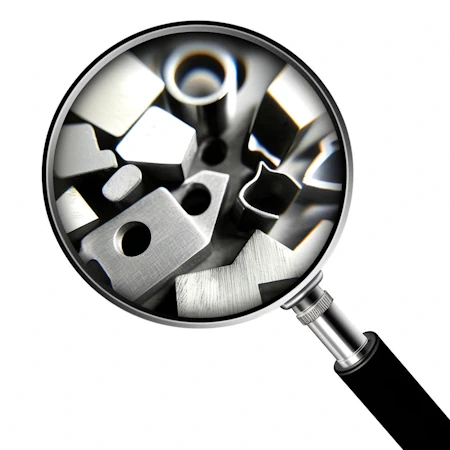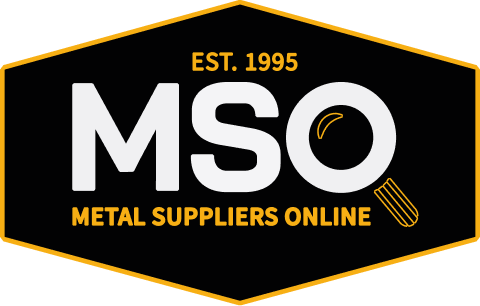Back To Browse
Titanium
Titanium 6Al-4V
Aging Procedure
Age at 538 C (1000 F) for 4 hours, air cool.
Annealing Procedure
Hold at 732 C(1350 F) between 1/4 and 4 hours, Furnace cool to 566 C(1050 F) then air cool. Furnace cooling is not required for forgings and bars.
Applications
6-4 is widely used in the aircraft industry in a variety of turbine and "hot" structural applications. It is generally employed in applications up to 400 C(750 F).
Cold Workability
The cold working characteristics of this material are similar to those of austenitic stainless steels. In multiple forming operations, intermediate stress relieving is recommended to offset the alloy's tendency to work harden. Post-work annealing is required to re-attain optimum performance characteristics.
Forgeability
Rough forge at 982 C(1800 F), finish at @ 968 C (1750 C).
Formability
This alloy may be hot or cold formed. Popular methods include hydropress, stretch or drop-hammer. This material responds similarly to 300 series stainless steels.
Heat Treatability
Solution treat at 904-954 C(1660-1750 F) for 2 hours followed by water quench.
Hot Workability
Hot forming will reduce both the springback and required forming forces, and will increase the overall ductility of the material.
Machinability
As a family, titanium and its alloys have developed a mystique as a nightmare to machine. This is simply not the case. Experienced operators have compared its characteristics to those found in 316 stainless steel. Recommended practice includes high coolant flow(to offset the material's low thermal conductivity), slow speeds and relatively high feed rates. Tooling should be tungsten carbide designations C1-C4 or cobalt type high speed tools.
Other Physical Properties
Beta Transus (F +/- 25) 1830
Principle Design Features
This alpha-beta grade is the most widely available and heavily used of all the titanium grades. The alloy is heat treatable and combines excellent strength and corrosion resistance with weld and fabricability. Beta Transus (F +/- 25) 1830.
Weldability
Rated as "fair" in terms of weldability.
Known Forms
Bar-Hollow
Casting
Closed Die Forgings
Flanges
Flat Bar
Forgings-Discs
Hexagon Bar
Open Die Forgings
Pipe-Seamless
Pipe-Welded
Plate
Plate-Clad
Plate-Tread
Rings
Rod-Threaded
Round Bar
Round Bar - Precision Ground
Seamless Rolled Rings
Sheet
Sheet-Flattened & Expanded
Sheet-Perforated
Square Bar
Strip
Tube-Rectangular
Tube-Round (Seamless)
Tube-Round (Welded)
Tube-Square
Wire Cloth
Wire Rod
Wire-Flat
Wire-Round
Wire-Shaped
Wire-Square
Wire-Welding
Billet
Bolts-Hex
Coil
Coil-Perforated
Contour Rings
Fasteners
Fittings
Forgings-Upset
Ingot
Mandrel Rings
Nuts
Shafts
Shapes-CD
Shapes-Extruded
Shapes-HR
Tube-Perforated
Valves
Welded Rings
Additional Data
Specifications
4905,4906,4911,4920,4928,4930,4934,4935,4954,4965,4967,B265,B348,B381,3.7164,1570,C50TF12,F-83142,T-81556,T-81915,T-9046,T-9047,M618,R56400Dismiss
Chemical Elements
| Aluminum | 5.5 - 6.75 |
| Carbon | 0.08 max |
| Hydrogen | 0.015 max |
| Iron | 0.25 max |
| Nitrogen | 0.05 max |
| Oxygen | 0.2 max |
| Titanium | Balance |
| Vanadium | 3.5 - 4.5 |
Physical Properties
Density: 0.16lb/in³
Electrical Resistivity: 171µΩ·cm
Melting Point: 3200°F
Specific Gravity: 4.43
Specific Heat: 0.135BTU/lb·°F
Thermal Conductivity: 0.325BTU/hr·ft·°F
Mechanical Properties
Modulus of Elasticity – Tension: 16.5MSI
Reduction of Area: 25%
Thermal Expansion
| Condition | Min | Max | Expansion Coefficient |
|---|---|---|---|
| Annealed | 32 °F | 212 °F | 5 µin/in/°F |
| Annealed | 32 °F | 600 °F | 5.3 µin/in/°F |
| Annealed | 32 °F | 1000 °F | 5.6 µin/in/°F |
| Annealed | 32 °F | 1200 °F | 5.9 µin/in/°F |
| Annealed | 32 °F | 1500 °F | 6.1 µin/in/°F |
Rupture Test Data
| Condition | Form | Temperature | Time | Rupture Strength |
|---|---|---|---|---|
| Test Specimen Annealed | Sheet | 800 °F | 1000 Hours | 75 KSI |
| Test Specimen Annealed | Sheet | 600 °F | 1000 Hours | 97 KSI |
Creep Test Data
| Condition | Form | Temperature | Time | Applied Stress | Creep Strain |
|---|---|---|---|---|---|
| Test Specimen Annealed | Sheet | 800 °F | 1000 Hours | 0.1 % | 32 mil/in |
| Test Specimen Annealed | Sheet | 600 °F | 1000 Hours | 0.1 % | 69 mil/in |
Mechanical Test Data
| Form | Sheet |
| Condition | Solution Annealed & Aged |
| Measurement Temperature | 70°F |
| Elongation | 10% |
| Reduction of Area | 25% |
| Tensile Strength | 130KSI |
| Yield Strength | 120KSI |
| Form | Sheet |
| Condition | Test Specimen Annealed |
| Measurement Temperature | 70°F |
| Form | Sheet |
| Condition | Test Specimen Annealed |
| Measurement Temperature | 600°F |
| Elongation | 17% |
| Reduction of Area | 52% |
| Tensile Strength | 100KSI |
| Yield Strength | 90KSI |
| Form | Sheet |
| Condition | Test Specimen Annealed |
| Measurement Temperature | 800°F |
| Elongation | 18% |
| Reduction of Area | 53% |
| Tensile Strength | 90KSI |
| Yield Strength | 75KSI |
| Form | Sheet |
| Condition | Test Specimen Annealed |
| Measurement Temperature | 1000°F |
| Elongation | 30% |
| Reduction of Area | 68% |
| Tensile Strength | 70KSI |
| Yield Strength | 60KSI |
Find the metal you're looking for today.

